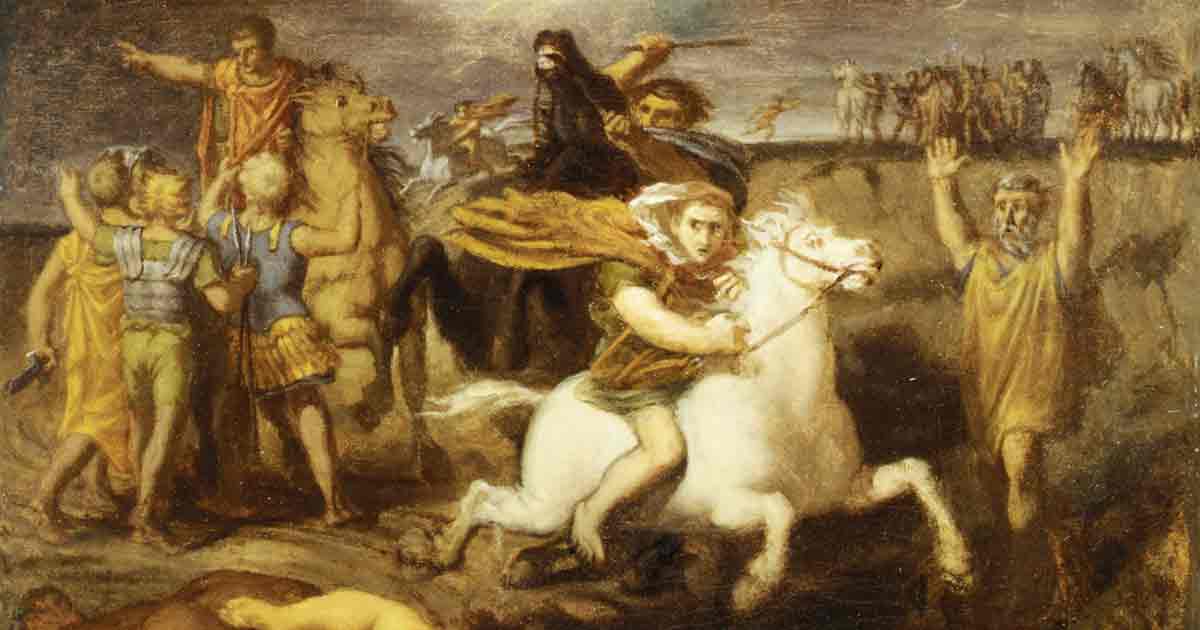Caesar’s Gambit: Reliving the Drama of the Gallic Wars
One of the principal aspects of growing empires is war. Throughout history, great kingdoms and realms were born at the expense of neighbors who were weaker and ripe for plunder. That is what happened to Gaul, a Western European region that was directly bordered by the ever-expanding Roman Republic.
To satisfy their thirst for more land, money and prestige, the Romans went into war against the Celts to their west, laying waste to their lands and embarking on an eight-year-long war. The ensuing Gallic Wars were a bloody and difficult era in the history of ancient Europe. But it is through these wars that the mighty Julius Caesar finally rose to unprecedented power. The question remains, was his war against the Gauls justified?
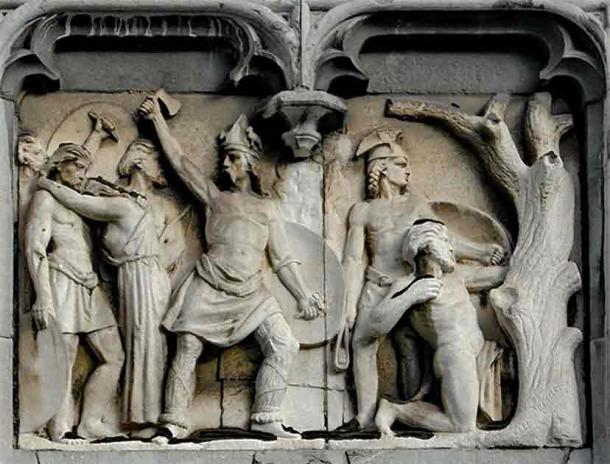
Sculpted relief of the Gallic leader Ambiorix at war with the Romans during the Gallic Wars. He was a leader of the Eburones tribe who played a significant role in the rebellion against Roman forces led by Julius Caesar in 54 BC. (Kleon3 / CC BY-SA 4.0)
Julius Caesar and the Prelude to the Gallic Wars
The Gallic Wars spanned the period from 58 BC to 50 BC, emerging as a critical juncture in the history of ancient Rome. It was one of their most important campaigns, which paved the way for the birth of the powerful Roman Empire. It came to fruition thanks to Julius Caesar's audacious foray into the region called Gaul, a vast and diverse expanse encompassing modern-day France, Belgium, Luxembourg and parts of neighboring territories. These were the lands inhabited predominantly by Celtic Gallic tribes, as well as Germanic and Brittonic peoples. Traditionally at strained peace with the Romans, in the years preceding the war the Gauls experienced increased pressures from their southerly neighbors.
- How Gaul ‘Barbarians’ Influenced Ancient Roman Religion
- 10 Fierce But Often Forgotten Enemies of Rome
The pressure ultimately broke into a monumental Roman campaign, driven by a combination of strategic imperatives, political maneuvering and personal ambition of mighty Julius Caesar. In the end, it not only showcased Caesar's military brilliance but also reshaped the geopolitical landscape of Western Europe for centuries to come.
The Gallic Wars were thus a crucible through which Caesar's mettle as a commander, statesman and visionary leader was tested, ultimately propelling him to unprecedented heights of power and influence within the Roman Republic, all the while leaving an indelible imprint on the tapestry of history. But how did the Gallic Wars erupt?
The genesis of the Gallic Wars lies in the increasing threat that was posed by the Helvetii, a confederation of Celtic tribes whose audacious migration southward across Roman territory in 58 BC sent shockwaves through the heights of power in Rome. Sensing both an opportunity to assert Roman authority and a strategic imperative to safeguard the Republic's borders, Julius Caesar, then a prominent general and statesman, marshaled the forces of the Republic to confront this perceived menace.
The ensuing clash at the Battle of Bibracte, marked by strategic maneuvering, tactical brilliance and decisive Roman victory, not only halted the Helvetii's advance but also solidified Caesar's standing within Rome's ruling elite. However, by that point, the Germanic tribe of the Suebi was also drawn into the conflict, meaning that the promise of war was stronger than ever.
![The Barbarians [referring to the Gauls] Before Rome, in a painting by Évariste Vital Luminais. (Public domain)](https://www.ancient-origins.net/sites/default/files/styles/large/public/the_3.jpg?itok=HXXLRg3S)
The Barbarians [referring to the Gauls] Before Rome, in a painting by Évariste Vital Luminais. (Public domain)
The Eruption of All-Out War Against the Celts
In the aftermath of the victory over the Helvetii, Caesar turned his gaze northward, embarking on a series of campaigns aimed at subduing other Gallic tribes and expanding Roman influence in the region. Engagements against formidable adversaries such as the Suebi and the Veneti showcased Caesar's martial prowess, strategic acumen and ability to navigate the intricate web of alliances and rivalries that defined Gallic politics.
Through a combination of military might, diplomatic finesse and calculated coercion, Caesar succeeded in asserting Roman hegemony over Gaul's northern territories, setting the stage for more ambitious conquests on the horizon.
Central to the narrative of the Gallic Wars were the pivotal battles and ingenious military stratagems devised by Caesar and his legions. At the Battle of Gergovia, in 52 BC, Caesar confronted what would prove to be one of his most formidable adversaries in the form of Vercingetorix, a charismatic Gaulish chieftain who rallied disparate Gallic tribes in a fierce resistance against Roman incursion. The ensuing clash, characterized by very brutal combat, shifting fortunes and tactical innovation on both sides, culminated in a rare setback for Caesar as he faced a major defeat at the hands of the Gallic forces.
Still, Caesar was not deterred by this initial setback and was quick to regroup his forces, learning from the mistakes he had made and adapting his strategies to meet the evolving challenges of the Gallic campaign. He pursued the weakened army of Vercingetorix and chased him all the way to the fortified town of Alesia. There, he confronted him once more.
The siege of Alesia happened in September of 52 BC and stands as a crowning achievement of Caesar's military career, a masterful display of siege warfare, engineering ingenuity and logistical prowess. It showed to the world that he was much more than a competent statesman and that he had all the prerequisites to become a powerful ruler.
Faced with the formidable defenses of the fortified hilltop town of Alesia, Caesar orchestrated a meticulously coordinated assault, encircling the Gaulish defenders with a vast network of fortifications, earthworks and siege engines. The ensuing siege, marked by relentless Roman pressure, desperate counterattacks and grueling attrition, ultimately culminated in the surrender of Vercingetorix and the capitulation of Alesia, cementing Caesar's dominance over Gaul and paving the way for its integration into the Roman Republic.
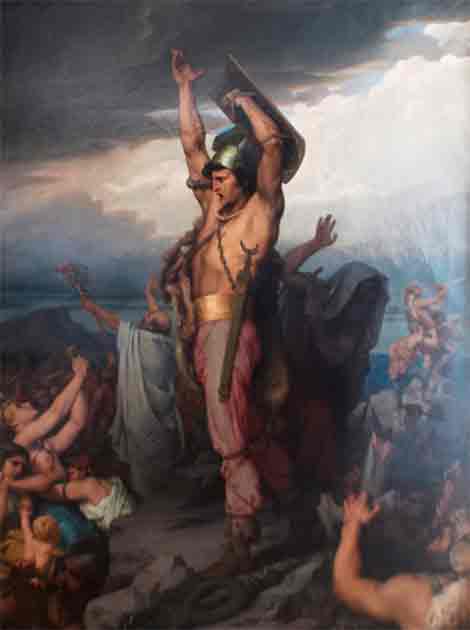
Vercingetorix Calling the Gauls to Defend Alésia during the Gallic Wars, by François-Émile Ehrmann. (Eunostos / CC BY-SA 4.0)
The Conquest of an Ancient Realm
By 50 BC, Caesar had effectively subdued much of Gaul, integrating it into the burgeoning Roman Republic and reaping the spoils of conquest in the form of wealth, resources and strategic advantages. His administration of Gaul, marked by a judicious blend of military might, administrative reform and diplomatic outreach, served to solidify Roman hegemony while laying the groundwork for its eventual assimilation into the Roman Empire. Caesar's introduction of Roman law, governance and infrastructure left an indelible imprint on Gaulish society, hastening its transformation into a bastion of Roman culture and civilization.
Still, the process of conquest and consolidation was not without its challenges and complexities. The Gallic Wars tested Caesar's leadership, resourcefulness and capacity for governance as he grappled with issues of insurgency, rebellion and internal dissent. The suppression of the Gallic revolt led by Vercingetorix in 52 BC, followed by subsequent pacification campaigns in the years that followed, required Caesar to employ a combination of military force, political acumen and strategic alliances to maintain control and stability in the region.
The legacy of the Gallic Wars reverberates through the pages of both Roman and European history, casting a long shadow over the fate of empires and the course of civilization. In many ways, it shaped the world as we know it today. Caesar's conquest of Gaul not only expanded Roman dominion to the farthest reaches of Western Europe but also catalyzed the dissemination of Roman culture, language and institutions.
The Gallic Wars served as a crucible in which Caesar's political ambition and military prowess converged, ultimately propelling him to the pinnacle of power within Rome. Most importantly, the Gallic Wars gave Caesar the power and the prestige he needed to begin his rise to becoming a dictator, paving the way towards the birth of the Roman Empire.
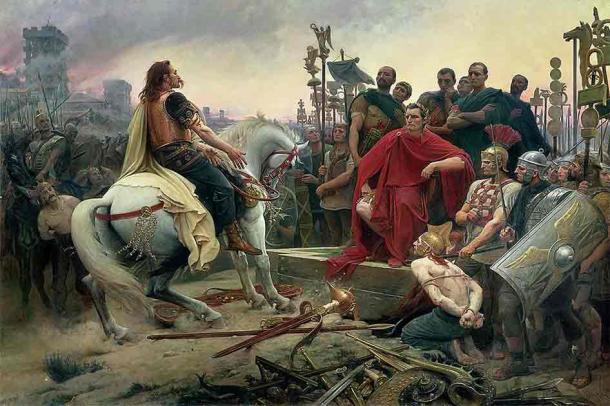
Vercingetorix throwing down his weapons at the feet of Julius Caesar after the Battle of Alesia, a pivotal point during the Gallic Wars. (Public domain)
Every War Comes at a Cost
However, the seeds of Caesar's demise were also sown amidst the triumphs of the Gallic Wars, as his consolidation of power and erosion of republican norms laid the groundwork for his assassination and the eventual crumbling of the Roman Republic. The Gallic Wars thus stand not only as a testament to Caesar's audacity and cunning but also as a cautionary tale of the perils inherent in the pursuit of absolute power. Similarly, they embody the complexities, contradictions and enduring significance of one of antiquity's most transformative epochs. When it comes to ancient military history, few campaigns rival the scale, significance and lasting impact of the Gallic Wars.
One of the foremost historical sources on these wars come directly from Julius Caesar. De Bello Gallico (meaning “On the Gallic War”) is his firsthand account of the Gallic Wars, providing invaluable insights into the military campaigns, political dynamics and cultural milieu of ancient Gaul. Written in Latin, likely between 50 BC and 40 BC, De Bello Gallico stands as one of the most influential works of military literature in history, offering a compelling narrative of Caesar's conquests and shaping subsequent perceptions of the Gallic Wars. It also helped historians learn so much about the ancient tribes of Gaul, as well as the wars themselves.
- “Veni, Vidi, Scripsi”: The Literary Conquests of Gaius Julius Caesar
- The Camillus Conundrum: Did Camillus Really Save Rome from the Gauls?
Caesar's narrative in De Bello Gallico served multiple purposes. Firstly, it served as a propaganda tool, bolstering Caesar's reputation in Rome as a victorious general and capable leader. By emphasizing his strategic brilliance, military prowess and benevolent governance, Caesar sought to secure support among the Roman populace and elite, consolidating his political power within the Republic.
Furthermore, the book functions as a historical document, providing valuable insights into the geography, ethnography and warfare of ancient Gaul. Caesar meticulously documented the various tribes, their customs, alliances and conflicts, offering a detailed portrait of Gallic society. Additionally, his vivid descriptions of battles, sieges and military tactics provide valuable lessons for future generations of military commanders and strategists. Without this book, we would likely know far less about the ancient Gauls than we do today.
Nevertheless, it's essential to approach De Bello Gallico with a critical eye, as Caesar's account is inherently biased and self-serving. As the primary protagonist and narrator, Caesar portrays himself in a favorable light, downplaying his failures and exaggerating his successes. Furthermore, Caesar's perspective as a Roman conqueror inevitably colors his portrayal of the Gallic tribes, often depicting them as “barbaric” and inferior to Roman civilization. Despite these limitations, De Bello Gallico remains a seminal work in the study of ancient history and military strategy. Its enduring influence lies not only in its historical significance but also in its literary merit, as Caesar's eloquent prose and vivid storytelling continue to captivate readers centuries after its composition.
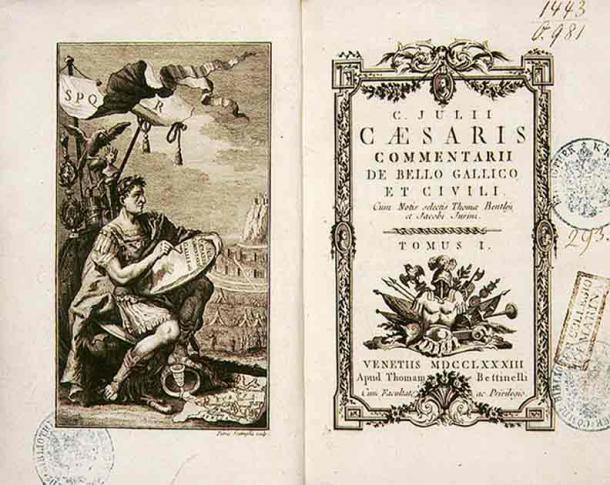
Cover of “De Bello Gallico,” the firsthand account of the Gallic Wars written by Julius Caesar. (Public domain)
Survival of the Strong: How the Gallic Wars Shaped the World
For eight long years, Caesar systematically brought the Gallic tribes down, often pitting them against one another, slowly subjugating them into the Roman Republic. These wars are thus a true historical lesson about true systematic warfare and a total domination over your enemy.
It’s important to remember that it took just eight years for Caesar to completely overpower Gaul. After the wars, the Gaulish tribes became a part of the Roman republic. Within just a few generations, they had lost much of their identity. Add a century or two, and their languages, customs and heritage were gone as well. That is all it took to completely erase various tribes and peoples from the pages of history, forever altering the course of their existence..
Top image: The Gaul Littavicus betraying the Roman cause and fleeing to support Vercingétorix during the Gallic Wars, in a painting by Théodore Chassériau citca 1838. Source: Public domain
References
Gilliver, K. 2024. Caesar's Gallic Wars: 58–50 BC. Bloomsbury USA.
River, C. 2014. The Gallic Wars: The Campaigns That Made Julius Caesar a Roman Legend. CreateSpace Independent Publishing Platform.
Stevenson, T. 2014. Julius Caesar and the Transformation of the Roman Republic. Routledge.
















